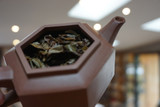From Cupping to Gong Fu... What is Next?

From Cupping to Gong Fu: Porcelain and Clay
A lot of times when we are talking about a Li Shan high mountain oolong the preferred method of brewing is gong fu brewing. What do we mean when we say preferred? There are a number of characteristics present in an yixing style pot that exalt its tea making ability. The clay body, the content of this clay and how it is structured and put together is what allows us tea brewers to really get the temperatures up. The clay contains iron, and some of the clays more iron, so I would use the metaphor of cooking in a cast iron skillet or that old seasoned pot. Seasoning is part of the appeal with these pots, but it is also the iron and the high temps that draw me in. We can always reach a lower temperature to brew with… but the clay allows us to reach a higher one. The porous nature of the clay makes it preferred over metal in case you were wondering why not use a metal pot. Throughout our personal history of tea, the consumer has been shaped by the market and vice versa. In one case, a company, well known, that I will not mention, promoted and sold these enamel coated cast iron kettles for decades. To this day, I still am asked about these kettles to be used as brew pots. I’m not a fan, after pulling one out of a commercial dishwasher in New York, lifting it to give it a sniff and surprised by the aroma of cigarette butts. Don’t put your clay yixing pots in the dishwasher!
“Do your friends in America know how to use these kind of pots?” “No…”
“What a shame…” And there you have it friends… What a shame!
But certainly not every tea occasion is an occasion for yixing clay teapots. And porcelain certainly is nice! So here we are at the cupping vessel. Jian Ding Bei. This device is very convenient when setting a set of standard parameters by which to brew tea…everything is uniform as long as everything is done the same.
